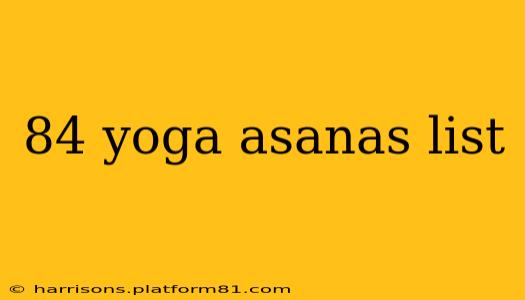84 Yoga Asanas: A Comprehensive Guide to Postures for Body and Mind
Yoga, an ancient practice originating in India, offers a diverse range of asanas (postures) designed to improve physical and mental well-being. While the exact number of asanas varies depending on the tradition and interpretation, the concept of 84 asanas is often referenced. This isn't a fixed, universally agreed-upon list, but rather a symbolic representation of the vast possibilities within yoga. This guide explores a selection of prominent and widely practiced asanas, categorized for clarity and understanding. Remember to always consult with a qualified yoga instructor before starting any new practice, especially if you have any underlying health conditions.
Note: This list does not encompass all 84 asanas in any single, definitive tradition. It represents a substantial selection of commonly practiced and beneficial poses.
Standing Poses (Standing Asanas)
These poses cultivate strength, balance, and stamina.
- Tadasana (Mountain Pose): The foundation of all standing poses, promoting grounding and stability.
- Vrksasana (Tree Pose): Improves balance and concentration.
- Trikonasana (Triangle Pose): Stretches the hamstrings, groin, and hips.
- Virabhadrasana I, II, III (Warrior Poses I, II, III): Builds strength and stamina, improves flexibility.
- Parsvakonasana (Extended Side Angle Pose): Stretches the legs and torso.
- Utthita Hasta Padangusthasana (Extended Hand-to-Big-Toe Pose): Improves balance and hip flexibility.
- Uttanasana (Standing Forward Bend): Stretches the hamstrings and calves.
Seated Poses (Sitting Asanas)
These asanas enhance flexibility, calm the mind, and promote meditation.
- Sukhasana (Easy Pose): A comfortable seated position for meditation.
- Padmasana (Lotus Pose): A deeply meditative pose requiring hip flexibility.
- Ardha Padmasana (Half Lotus Pose): A variation of Lotus pose.
- Siddhasana (Accomplished Pose): Another comfortable seated meditation pose.
- Bhadrasana (Humble Pose): A comfortable seated position with legs crossed.
- Virasana (Hero Pose): A kneeling pose that stretches the ankles and thighs.
- Janu Sirsasana (Head-to-Knee Pose): Stretches the hamstrings and hips.
- Paschimottanasana (Seated Forward Bend): A deep stretch for the entire back of the body.
Backbends (Backbending Asanas)
These poses open the chest, improve posture, and increase spinal flexibility.
- Bhujangasana (Cobra Pose): Gently stretches the chest and abdomen.
- Dhanurasana (Bow Pose): A more intense backbend requiring strength and flexibility.
- Urdhva Dhanurasana (Wheel Pose): A challenging backbend requiring significant strength and flexibility.
- Shalabhasana (Locust Pose): Strengthens the back muscles.
- Ustrasana (Camel Pose): A deep backbend that opens the chest and shoulders.
Forward Bends (Forward Bending Asanas)
These poses calm the nervous system and promote relaxation.
- Adho Mukha Svanasana (Downward-Facing Dog): A full-body stretch that strengthens and lengthens the body.
- Uttanasana (Standing Forward Bend): Already mentioned above, it is also a potent forward bend.
- Paschimottanasana (Seated Forward Bend): Already mentioned above.
- Pashimottanasana variations: There are many variations to deepen this stretch.
Twists (Twisting Asanas)
Twists stimulate internal organs and improve digestion.
- Bharadvajasana I (Bharadvaja's Twist I): A seated twist that stretches the spine.
- Ardha Matsyendrasana (Half Lord of the Fishes Pose): A seated twist that opens the chest and shoulders.
- Parivrtta Trikonasana (Revolved Triangle Pose): A standing twist that strengthens and stretches the body.
Inversions (Inversion Asanas)
Inversions improve circulation and can calm the nervous system.
- Adho Mukha Svanasana (Downward-Facing Dog): While often categorized as a forward bend, it also has inverting qualities.
- Sirsasana (Headstand): A challenging inversion requiring significant strength and balance.
- Salamba Sirsasana (Supported Headstand): A supported variation of Headstand.
- Sarvangasana (Shoulder Stand): An inversion that stimulates the thyroid and parathyroid glands.
- Halasana (Plow Pose): A less intense inversion than Shoulder Stand.
Restorative Poses (Restorative Asanas)
These poses promote relaxation and stress reduction.
- Savasana (Corpse Pose): A crucial pose for relaxation and integration of the practice.
- Supta Matsyendrasana (Reclined Spinal Twist): A gentle twist promoting relaxation.
- Supported Child's Pose: A variation of Child's pose with added support.
This list provides a glimpse into the vast world of yoga asanas. Remember, the journey of yoga is personal, and the best asanas for you will depend on your individual needs and preferences. Consistent practice, proper guidance, and listening to your body are key to reaping the many benefits of yoga.
Frequently Asked Questions (FAQs)
What are the benefits of practicing yoga asanas?
Yoga asanas offer a multitude of benefits, including increased flexibility, strength, and balance. They can also reduce stress, improve sleep, and promote overall well-being.
How often should I practice yoga?
The frequency of practice depends on your individual goals and fitness level. Aim for consistency rather than intensity. Even a short daily practice can be beneficial.
Is yoga suitable for everyone?
While generally safe, certain asanas may not be suitable for individuals with specific health conditions. It is always advisable to consult with a doctor or qualified yoga instructor before beginning any new yoga practice.
Can I learn yoga asanas from online resources?
While online resources can be helpful, it's crucial to receive proper instruction from a qualified teacher to ensure correct alignment and avoid injuries. Online resources should supplement, not replace, in-person instruction.
Are there variations of these asanas for different fitness levels?
Absolutely! Many asanas have variations for beginners, intermediate, and advanced practitioners. A good instructor will guide you towards appropriate modifications.
